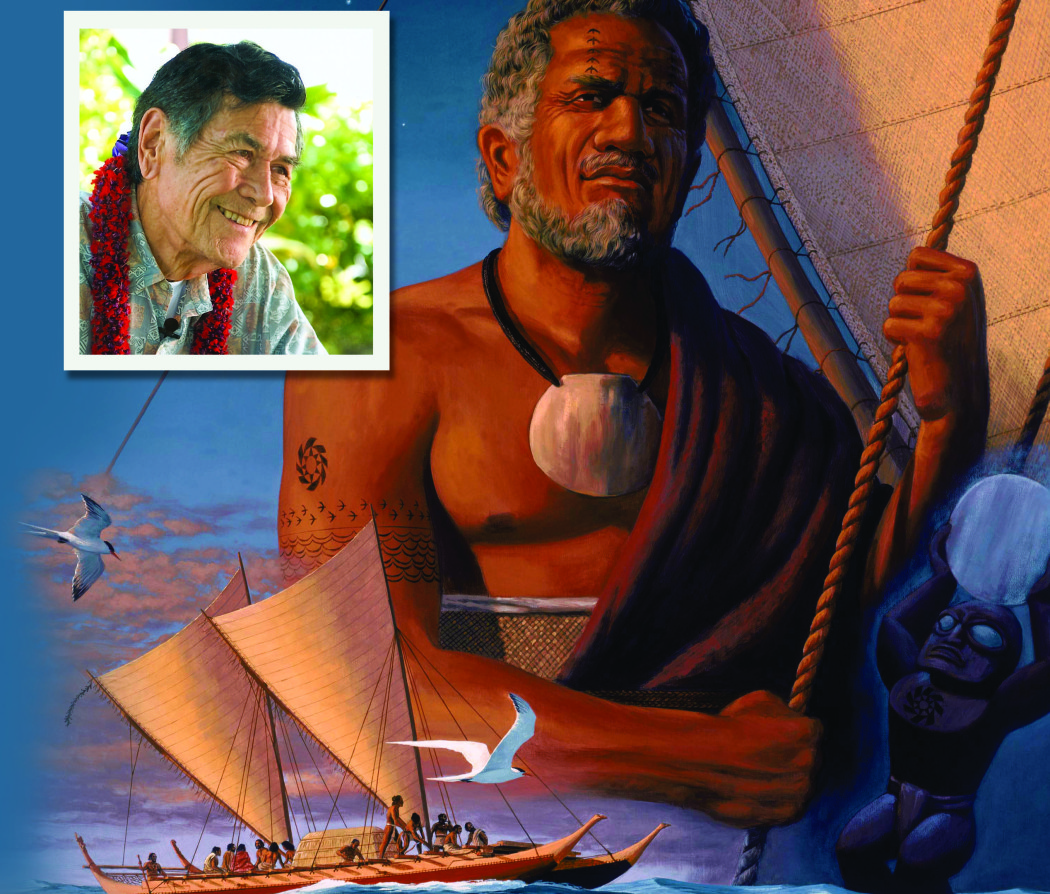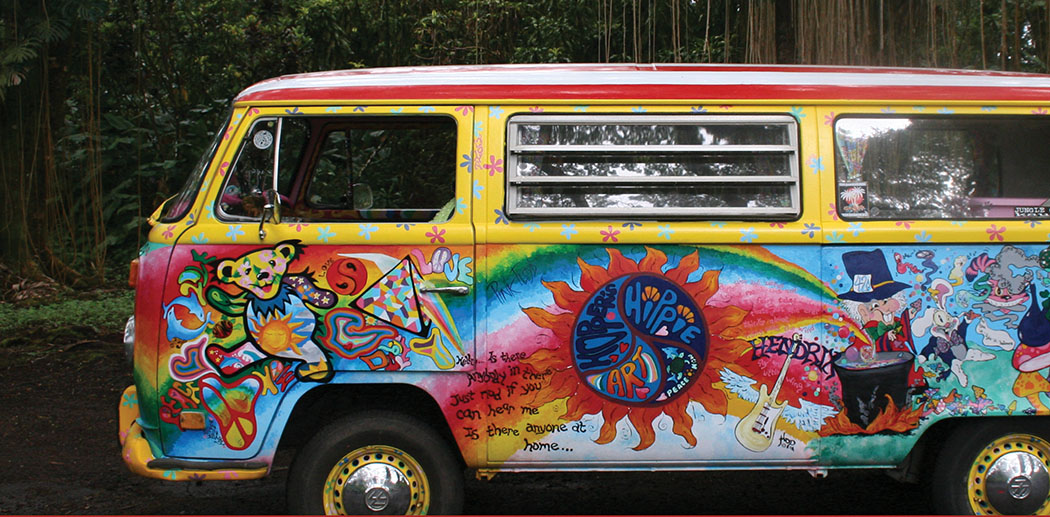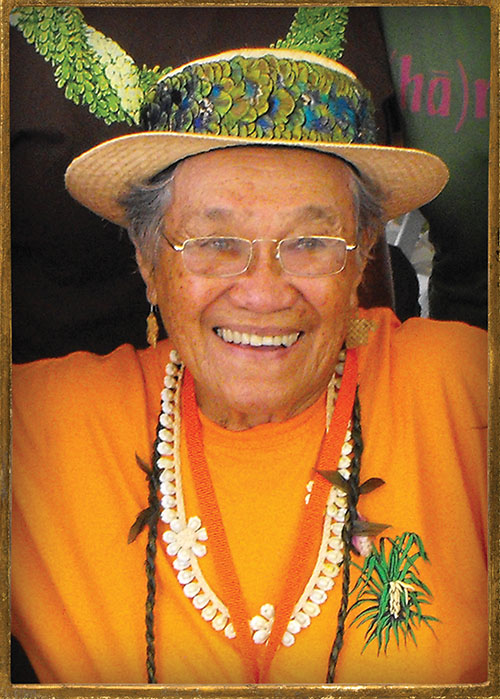
Herb Kawainui Kāne, Larger Than Life
 By Karen Valentine
By Karen Valentine
Setting sail in the weather and sea conditions of home port, we begin our journeys in life. As we stretch out across the vast seas of experience, our course is adjusted with input from sources that reveal themselves along the way: changing winds, inspirations, desires and even messages from the spirit world, voices of the ancestors.
Such was the course of Herb Kawainui Kāne, a Hawaiian hapa haole, mainland-educated, larger-than-life icon—cultural interpreter, reflector of beauty, visual storyteller, re-creator of ancient life scenes, initiator of a cultural renaissance, wielder of a magic paintbrush and founder of a society of ocean navigators.
Herb set his own course, beginning with the single choice to become an artist, sometimes contrary to the advice of others, including his father and art-world trends, which he defied with characteristic determination. In so doing he became a peerless and popular success. But that’s not the end of the story.
Born in 1928 and raised in Hilo and Waipi‘o Valley, Herb moved to Chicago to study art, to Honolulu when his spirit called him back to Hawai‘i, and back home to Hawai‘i Island’s Kealakekua before he made his final passage on March 8, 2011.
Along the way, Herb Kāne amassed a prolific life’s body of work including paintings, murals, U.S. Postal stamps and published illustrations that blend realism, romanticism and mythology to tell a visual story. When Kāne attended Chicago’s School of the Art Institute, after serving in the U.S. Navy, artistic trends were turning away from photographic realism reminiscent of painters such as Thomas Hart Benton and Grant Wood, two painters admired by Kāne. Abstract expressionism was all the rage, but the young student worked to hone his skills in rendering the human figure, settings and landscapes realistically, although enhanced by a romanticized ideal. These skills suited him to jobs illustrating commercial art, which he practiced for a short time, with little satisfaction. “The end came when I won a Jolly Green Giant campaign, and for a year, did drawings and paintings of that big green fairy until I could no longer suffer it,” Kāne said.
Change of Course
Kāne had been nurturing a passion for sailing his catamaran on Lake Michigan, and had begun researching Hawaiian canoes in the library of the University of Chicago and the Field Museum of Natural History, where an extensive collection of Pacific island cultural artifacts had been installed.
Herb started drawing sailing canoes and created a series of paintings of Polynesian canoes, which were purchased in 1969 by the Hawai’i State Foundation of Culture and the Arts. This purchase made it possible for him to move back to Hawai’i, where he lived in Honolulu and continued his passion and study of Polynesian voyaging canoes. As he said, the canoe brought him back home.
Being in Hawai‘i once again brought back images from his childhood. Herb’s father had come from a family of taro farmers in Waipi‘o Valley, where the Kāne family sometimes stayed. Legends and ghost stories abounded by the lantern light as his father shared tales of the ancestors with his son. Images started forming in the young boy’s mind, images that would one day appear on gigantic murals and paintings for all to see—Hawaiians, malihini, kama‘aina and visitors to Hawai‘i some decades into the future.
Kāne brought the history and culture alive for the public and the Hawaiian people who had at one time been stripped of their cultural identity. He not only recalled legends, but extensively researched historical accounts and 18th century illustrations to create historically accurate art that is characterized by an emphasis on realistic and precise draftsmanship when depicting historical scenes. His series of voyaging canoe paintings and many other paintings of battles, everyday domestic life, and ceremonial occasions contain exquisite detail and color harmonies that bring each scene to life.
U.S. Sen. Daniel Akaka said of Kāne: “Herb Kāne was a Titan and a giant amongst Hawaiian historians who has left his legacy in his artwork and his words of wisdom as a gift of Aloha to Hawai’i nei and to the rest of the world.”
Over the years, the public embraced the artist and, as if starved for life and breath, breathed in and lapped up every new painting as it was unveiled. Herb Kāne paintings are on display at Bishop Museum, major resorts, Hawai’i Volcanoes National Park and in the Hawai’i State Capitol. His paintings of Polynesian sailing, in particular, have been widely reproduced, appearing as illustrations in books and articles. A major commission was a series of seven paintings for National Geographicmagazine and published in the December 1974 issue. A good writer himself, Herb published several books of Hawaiian history and personal accounts, illustrated with his paintings. They include Voyage, the Discovery of Hawai‘i (1976), Pele, Goddess of Volcanoes (1967), Voyagers (1991) and Ancient Hawai‘i (1997).
Kāne’s dedication to accuracy and lifelike detail was important to depicting historical accounts, but when he turned his imagination to the legends of old Hawai’i and the spiritual and mythological side of the Hawaiian culture, his work is more expressionistic. In his painting Pele, Goddess of the Volcano for the Jaggar Museum at Kīlauea, the supernatural figure is depicted with literal fire in her eyes and flowing lava as her hair.
In an intriguing blend of realism and supernatural, Kāne himself reported several instances of “chicken-skin” accounts of people seeing figures stepping out of his paintings, and voices coming from scenes in the paintings.
He created several oversized canvasses and murals for hotel lobbies, public and commercial spaces. His 1973 mural, made of wool, titled “Opening of the Pacific to Man,” was designed for the entrance to the Pacific Trade Center in Honolulu. It measures 43 feet long and11 feet high and offers views of several voyaging canoes and a central monumental male figure holding a paddle. In the corner of the mural is a representation of the wayfarer’s chart, traditionally made of shells and sticks, in which islands and ocean swell patterns are encoded to assist the training of a navigator. Kāne was commissioned by the National Park Service in 1976 to paint “Keoua’s Arrival,” which is on permanent display in the Visitor Center at Pu’ukoholā Heiau National Historic Site. One 1973, site-specific mural, painted on a custom-designed wall as part of a history center under construction (and never completed) at Punalu‘u Black Sand Beach, became an object of crime and mystery. The 24-foot-wide historical mural, titled “Ancient Punalu‘u, Hawai’i Island,” depicting a scene at Punalu‘u, survived the 1975 tsunami that destroyed the interior of the building. According to eyewitnesses, the wave pushed all the displays out the far side of the room and left a mud line three or four feet high on the wall—except on the mural, which was dry and undamaged. Then in 2005 the mural was stolen from the vacant site. Thieves are believed to have cut out the wall in five sections removing the painting in sections. To this day, it has never been recovered. Kāne responded by recreating a version of the mural in oil paint on canvas, saying, “Now all the thieves have is a preliminary sketch. Vengeance is mine.”
Artist Turned Naval Architect
Perhaps the artist’s greatest work of art, and the one that has the farthest reaching impact isn’t a painting at all, but one that looks like it emerged directly from a Herb Kāne painting—the Hōkūle‘a. In fact, it did.
His detailed drawings of Polynesian canoes, completed during his research for paintings, became a foundation for building a real canoe.
While living in Honolulu, Kāne attracted a group of sailing enthusiasts, including University of Hawai’i anthropologist Ben Finney and Tommy Holmes, author of The Hawaiian Canoe. Together they founded the Polynesian Voyaging Society and began building the Hōkūle‘a, a wa’a kaulua, a Polynesian double-hulled voyaging canoe, based on historical Polynesian design and capable of sailing between Hawai’i and Tahiti. Their purpose was to prove that ancestral Polynesian voyagers could have purposely navigated in vessels of similar type to
colonize Hawai’i.
“Even more intriguing to me was the thought that recreating the central object of the ancient culture and taking it to sea might stimulate the growing interest in a cultural revival,” Kāne said. He drew sketches for the canoe and made a painting for inspiration and to raise money.
Kāne designed this accurate, full-scale replica of a Polynesian voyaging canoe and named it Hōkūle‘a after the name came to him in a dream. Hōkūle‘a is the Hawaiian name for the star Arcturus, which was the guiding star in celestial navigation for Pacific voyages to the Hawaiian Islands. It is the zenith star that sits above Hawai‘i. The canoe was launched on March 8, 1973, and Kāne served as the skipper for two years as the canoe and novice crew sailed among the Hawaiian Islands to attract crew and support for its maiden international voyage.
Kāne’s role in the creation and promotion of the Hōkūle‘a helped restore pride of heritage to the peoples of the Pacific. Kāne’s colleague, Nainoa Thompson, navigator of the Hōkūle‘a, says Kāne was “the visionary, the dreamer, and he was the architect and the engineer. He’s the one that carried the burden of building, and constructing, and sailing Hōkūle‘a.” Elsewhere, Thompson told an interviewer, “When you look at Herb’s legacy, it is transforming Hawai’i’s society because he brought pride and culture and inspiration back, through the canoe….He is the father of the Hawaiian Renaissance.”
In 1984, Kāne was named a Living Treasure of Hawai‘i
In his book, Voyagers, Kāne refers to himself as an art historian, a breed of which there are only a handful in the U.S. Rather than writing about history, these artists illustrate history. He was particularly rewarded when, after viewing the mural depicting the war temple at Pu‘ukoholā, the huge heiau near Kawaihae, “a young Hawaiian admitted that he had always regarded the present remains of the old temple platforms as ‘just piles of rock.’ But you show me not only the rock platform that remains today, but the buildings, the altar, the fire—all gone now. And you even show the people. Even if they restored the place, they could not bring back the people. After what this painting said to me, I can never again look at any heiau as just a pile of rock.”
Herb didn’t avoid some of the dark side of history. He painted vast and vicious battle scenes, such as “The Battle at Nu‘uanu Pali.” The proud beauty of the native Hawaiian human figure stands out in all of Kāne’s exquisite and colorful renderings. The land positively glows under Kona sunsets and volcanic eruptions. The sea and surf are realistically powerful as the ships, canoes and their navigators sail forward to glory or doom.
For millions of people, Herb Kāne’s paintings are Hawai‘i. ❖
To see more Herb Kāne paintings and prints for sale, visit www.HerbKaneStudio.com
Images courtesy of the Herb Kāne estate.
Contact writer Karen Valentine at Karen@keolamagazine.com.


